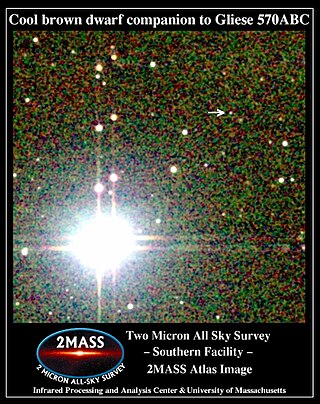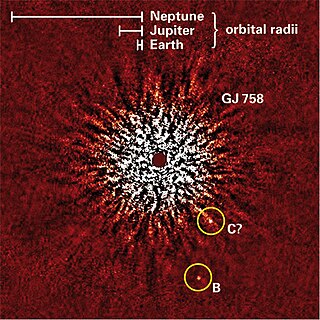
Gliese 570 is a quaternary star system approximately 19 light-years away. The primary star is an orange dwarf star. The other secondary stars are themselves a binary system, two red dwarfs that orbit the primary star. A brown dwarf has been confirmed to be orbiting in the system. In 1998, an extrasolar planet was thought to orbit the primary star, but it was discounted in 2000.

Gliese 436 is a red dwarf located 31.9 light-years away in the zodiac constellation of Leo. It has an apparent visual magnitude of 10.67, which is much too faint to be seen with the naked eye. However, it can be viewed with even a modest telescope of 2.4 in (6 cm) aperture. In 2004, the existence of an extrasolar planet, Gliese 436 b, was verified as orbiting the star. This planet was later discovered to transit its host star.
Gliese 777, often abbreviated as Gl 777 or GJ 777, is a binary star approximately 52 light-years away in the constellation of Cygnus. The system is also a binary star system made up of two stars and possibly a third. As of 2005, two extrasolar planets are known to orbit the primary star.
Gliese 674(GJ 674) is a small red dwarf star with an exoplanetary companion in the southern constellation of Ara. It is too faint to be visible to the naked eye, having an apparent visual magnitude of 9.38 and an absolute magnitude of 11.09. The system is located at a distance of 14.85 light-years from the Sun based on parallax measurements, but is drifting closer with a radial velocity of −2.9 km/s. It is a candidate member of the 200 million year old Castor stream of co-moving stars.

Gliese 105 is a triple star system in the constellation of Cetus. It is located relatively near the Sun at a distance of 23.6 light-years. Despite this, even the brightest component is barely visible with the unaided eye (see Bortle scale). No planets have yet been detected around any of the stars in this system.
Gliese 849, or GJ 849, is a small, solitary star in the equatorial constellation of Aquarius. It has a reddish hue and is invisible to the naked eye with an apparent visual magnitude of 10.41. The distance to this star is 28.8 light-years based on parallax, but it is drifting closer to the Sun with a radial velocity of −15.3 km/s. It has a pair of confirmed gas giant companions.
Gliese 832 is a red dwarf of spectral type M2V in the southern constellation Grus. The apparent visual magnitude of 8.66 means that it is too faint to be seen with the naked eye. It is located relatively close to the Sun, at a distance of 16.2 light years and has a high proper motion of 818.16 milliarcseconds per year. Gliese 832 has just under half the mass and radius of the Sun. Its estimated rotation period is a relatively leisurely 46 days. The star is roughly 6 billion years old.
Gliese 86 is a K-type main-sequence star approximately 35 light-years away in the constellation of Eridanus. It has been confirmed that a white dwarf orbits the primary star. In 1998 the European Southern Observatory announced that an extrasolar planet was orbiting the star.
Gliese 176 is a small star with an orbiting exoplanet in the constellation of Taurus. With an apparent visual magnitude of 9.95, it is too faint to be visible to the naked eye. It is located at a distance of 30.9 light years based on parallax measurements, and is drifting further away with a heliocentric radial velocity of 26.4 km/s.
Gliese 676 is a 10th-magnitude wide binary system of red dwarfs that has an estimated minimum separation of 800 AU with an orbital period of greater than 20,000 years. It is located approximately 54 light years away in the constellation Ara. In 2009, a gas giant was found in orbit around the primary star, in addition to its confirmation in 2011 there was also a strong indication of a companion; the second gas giant was characterised in 2012, along with two much smaller planets.

Gliese 758 is a star in the northern constellation of Lyra. At about magnitude 6 it is a challenge to view with the naked eye even in good seeing conditions, but can be easily seen through a small telescope or binoculars. Parallax measurements from the Hipparcos mission give it an estimated distance of around 50.9 light-years from Earth.

Gliese 163 is a faint red dwarf star with multiple exoplanetary companions in the southern constellation of Dorado. Other stellar catalog names for it include HIP 19394 and LHS 188. It is too faint to be visible to the naked eye, having an apparent visual magnitude of 11.79 and an absolute magnitude of 10.91. This system is located at a distance of 49.4 light-years from the Sun based on parallax measurements. Judging by its space velocity components, it is most likely a thick disk star.
Gliese 221, also known as BD-06 1339, is a star with an exoplanetary companion in the equatorial constellation of Orion. It is too faint to be visible to the naked eye, having an apparent visual magnitude of 9.70 and an absolute magnitude of 8.15. Using parallax measurements, the distance to this system can be estimated as 66.2 light-years. It is receding from the Sun with a radial velocity of +23 km/s. This is a high proper motion star, traversing the celestial sphere at an angular rate of 0.333″·yr−1.
59 Virginis is a G-type main-sequence star, located in constellation Virgo at approximately 57 light-years from Earth.
Gliese 180, is a small red dwarf star in the equatorial constellation of Eridanus. It is invisible to the naked eye with an apparent visual magnitude of 10.9. The star is located at a distance of 39 light years from the Sun based on parallax, and is drifting closer with a radial velocity of −14.6 km/s. It has a high proper motion, traversing the sky at the rate of 0.765 arcseconds per year.
Gliese 686 is a star in the constellation of Hercules, with an apparent magnitude +9.577. Although it is close to the Solar System – at 26.6 light-years – it is not the closest known star in its constellation, since Gliese 661 is 20.9 light years away. The closest system to this star is the bright μ Herculis, at 4.5 light years. They are followed by GJ 1230 and Gliese 673, at 7.2 and 7.6 light years respectively.

Gliese 569 is a ternary star system composed of a main-sequence star orbited by a pair of brown dwarfs in the constellation of Boötes about 32 light years away.
Gliese 514, also known as BD+11 2576 or HIP 65859, is a M-type main-sequence star, in the constellation Virgo 24.85 light-years away from the Sun. The proximity of Gliese 514 to the Sun was known exactly since 1988.











